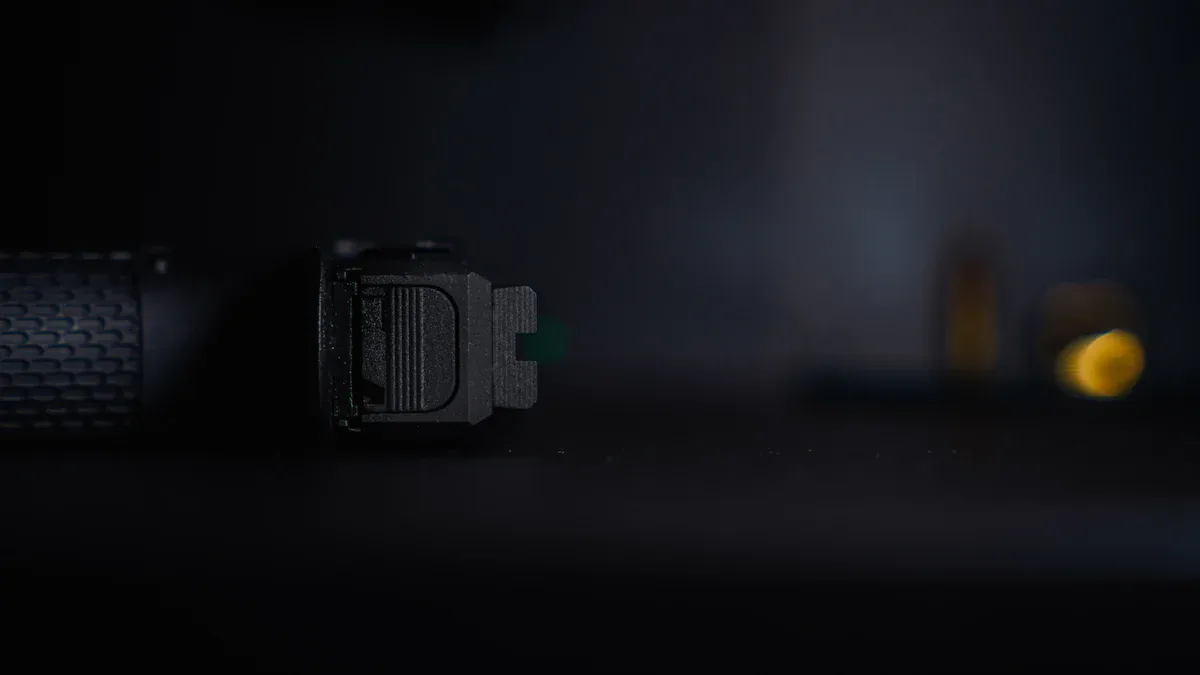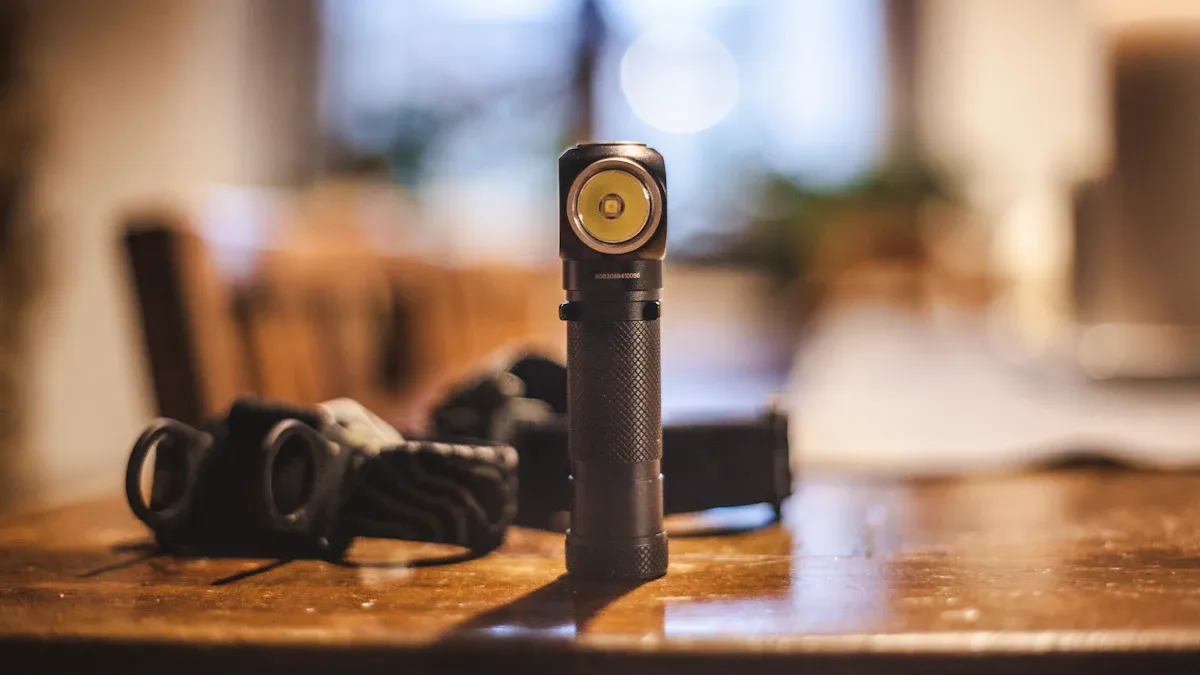How Flashlights Can Help You Navigate Your Home During a Blackout

Power outages are more common than you might think. Approximately 25% of U.S. households experience them annually, leaving millions without light. Severe weather, wildlife, and equipment failures are leading causes. During these moments, flashlights become essential. They provide portable, reliable light, helping you avoid accidents and navigate safely. A helius flashlight, known for its durability, ensures you’re prepared for emergencies.
Key Takeaways
Flashlights give steady light when the power goes out. They help you move safely and prevent accidents.
Pick good flashlights with SOS and flashing modes for extra safety and use.
Store flashlights in easy-to-reach spots in every room. Use rechargeable batteries so they are ready for emergencies.
Why Flashlights Are Essential During a Power Outage

Reliable Light Source in Emergencies
Flashlights are indispensable during a power outage because they provide dependable illumination when you need it most. Unlike other emergency lighting options, flashlights excel in efficiency and brightness. LED flashlights, for instance, ensure optimal performance, even in the darkest conditions. High-quality models are built to endure harsh environments, making them a trustworthy tool in critical situations. Whether you’re navigating through your home or signaling for help, flashlights serve multiple purposes, enhancing their reliability.
Feature | Description |
|---|---|
SOS Mode | Sends a distress signal to alert rescuers. |
Strobe Mode | Attracts attention or distracts potential threats. |
Multi-mode | Offers adjustable brightness levels to conserve battery or maximize light. |
These features make flashlights your ultimate survival tool during emergencies, ensuring you’re never left vulnerable.
Safer Alternative to Candles
Using candles during a power outage may seem convenient, but it comes with significant risks. Candles can easily ignite nearby objects, creating a fire hazard. According to safety guidelines, you should avoid candles whenever possible and opt for flashlights or glowsticks instead. If candles are your only option, never leave them unattended or place them near flammable materials. Flashlights eliminate these dangers entirely, offering a safer and more practical solution for emergency lighting.
Enhancing Safety and Preventing Accidents
During a blackout, navigating your home can be challenging and dangerous. Flashlights provide immediate illumination, helping you stay calm and focused. They act as your first line of defense against hidden hazards, such as furniture or debris, that could cause trips or falls. With a flashlight in hand, you can confidently move through dark spaces, reducing the risk of injuries. Severe weather events, like thunderstorms and hurricanes, account for most power outages, making flashlights an essential tool for maintaining safety in these scenarios.
Flashlights illuminate obstacles, ensuring safe navigation.
They help you identify hazards, preventing accidents.
Their portability allows you to carry light wherever it’s needed.
By providing a reliable light source, flashlights enhance your ability to respond effectively during emergencies, keeping you and your loved ones safe.
Choosing the Right Flashlight for Emergencies

Handheld Flashlights for Focused Light
Handheld flashlights are essential for emergencies due to their focused beam and portability. These battery-operated lights provide reliable illumination during prolonged power outages. Their directional light helps you navigate dark spaces, inspect wounds, or locate supplies. Many models include strobe functions, which can signal for help or disorient potential threats.
When selecting a handheld flashlight, prioritize brightness and durability. Look for models with at least 1,000 lumens for effective visibility. Sturdy construction ensures they withstand drops and impacts, making them a dependable choice for home safety.
Headlamps for Hands-Free Use
Headlamps offer hands-free convenience, allowing you to perform tasks safely during blackouts. Their adjustable brightness levels ensure the right amount of light for activities like cooking or fixing appliances. Rechargeable headlamps eliminate the need for disposable batteries, making them an eco-friendly alternative lighting option.
These devices are built to endure tough conditions, such as rain or extreme temperatures. Their hands-free design directs light exactly where needed, enhancing efficiency and safety in emergencies.
Lantern-Style Flashlights for Broader Coverage
Lantern-style flashlights provide broader light coverage, illuminating entire rooms or outdoor spaces. Unlike handheld flashlights, which focus on a single point, lanterns emit omnidirectional light. This makes them ideal for activities like reading or cooking during a blackout.
Lanterns consume less power and often have longer run times, making them a practical backup lighting option. Their ability to light up large areas ensures you can maintain home safety even in extended outages.
The Benefits of a Helius Flashlight
The helius flashlight stands out for its durability and advanced features. Constructed from titanium, it withstands drops and extreme weather conditions. Its powerful illumination, with an output of 700 lumens, ensures bright visibility in dark environments.
This flashlight includes multiple lighting modes, such as strobe and SOS, for emergency signaling. The hybrid dual-core power system supports both rechargeable and standard batteries, offering flexibility during emergencies. With its robust design and innovative features, the helius flashlight is a superior choice for alternative lighting options.
Tips for Using Flashlights During a Blackout
Keep Flashlights Accessible
Keeping flashlights within easy reach ensures you can quickly find them during a blackout. Place at least one flashlight in every major room, such as bedrooms, the kitchen, and the living room. This distribution minimizes the time spent searching for light sources in the dark. Test your flashlights monthly to confirm they work properly, and replace the batteries as needed. Storing spare batteries or a solar charger in your emergency supplies guarantees you’ll have power when you need it most.
Tip: Organize your emergency supplies in a central location to make flashlights and extra batteries easier to locate during an outage.
Use Long-Lasting or Rechargeable Batteries
Using rechargeable batteries in your flashlights offers several advantages. These batteries save money over time since they can be reused hundreds of times before replacement. They also reduce waste, making them an environmentally friendly choice. Rechargeable flashlights often maintain consistent brightness throughout their lifespan, ensuring reliable lighting during emergencies. Many models are compact, lightweight, and water-resistant, making them ideal for various situations.
Rechargeable batteries not only enhance flashlight performance but also promote sustainability by reducing hazardous waste and lowering your carbon footprint.
Regular Maintenance and Testing
Routine maintenance ensures your flashlights remain functional when you need them most. Conduct monthly check-ups if you use them daily or bi-yearly inspections for less frequent use. During these check-ups, wipe down the exterior, inspect battery contacts for corrosion, and test the switch and light modes. Check the seal around the lens and tail cap to ensure it remains intact. Regular testing prevents unexpected failures and extends the lifespan of your flashlights.
Store Flashlights Safely to Avoid Damage
Proper storage protects your flashlights from damage and ensures they’re ready for use. Keep them in a cool, dry place to prevent corrosion and avoid exposure to direct sunlight, which can degrade materials and batteries. Remove batteries if you don’t plan to use the flashlight for an extended period to prevent leakage. For high-end models, consider using a protective case to shield them from physical damage.
Improper storage can lead to accidental activation, overheating, or even battery explosions. Always handle flashlights and batteries with care to avoid these risks.
Flashlights are indispensable tools for ensuring safety and convenience during a blackout. They provide quick illumination, helping you stay calm and avoid accidents. Choosing the right flashlight enhances your emergency preparedness. Look for models with high brightness, durable construction, and rechargeable batteries. By keeping flashlights accessible and functional, you can confidently navigate your home during any power outage.
Tip: Store flashlights in multiple rooms and vehicles to stay ready for unexpected emergencies.
FAQ
How can you prepare for a power outage in advance?
You should create a safety plan, stock emergency supplies, and ensure flashlights with working batteries are accessible. This power outage preparedness reduces risks and enhances safety.
What type of flashlight is best for emergencies?
Choose durable flashlights with rechargeable batteries. Lantern-style models provide broad coverage, while handheld flashlights offer focused light. Headlamps allow hands-free use during emergencies.
How often should you check your emergency flashlights?
Test your flashlights monthly to ensure functionality. Replace batteries as needed and inspect for damage. Regular maintenance ensures your preparedness during a power outage.
See Also
A Homeowner's Guide to Selecting the Ideal Emergency Flashlight
Essential LED Flashlights Every Homeowner Should Have
Camping Essentials: Comparing Lanterns and Flashlights for Adventures
